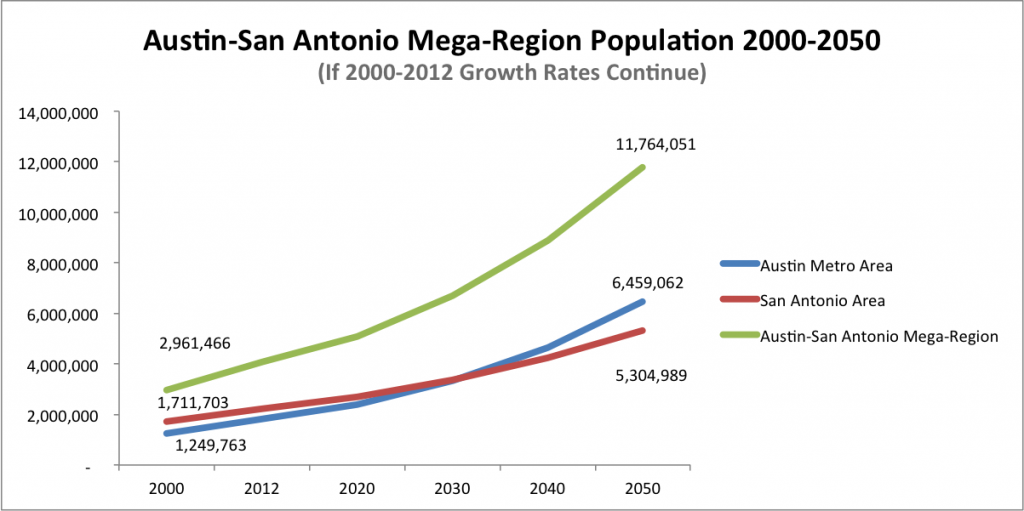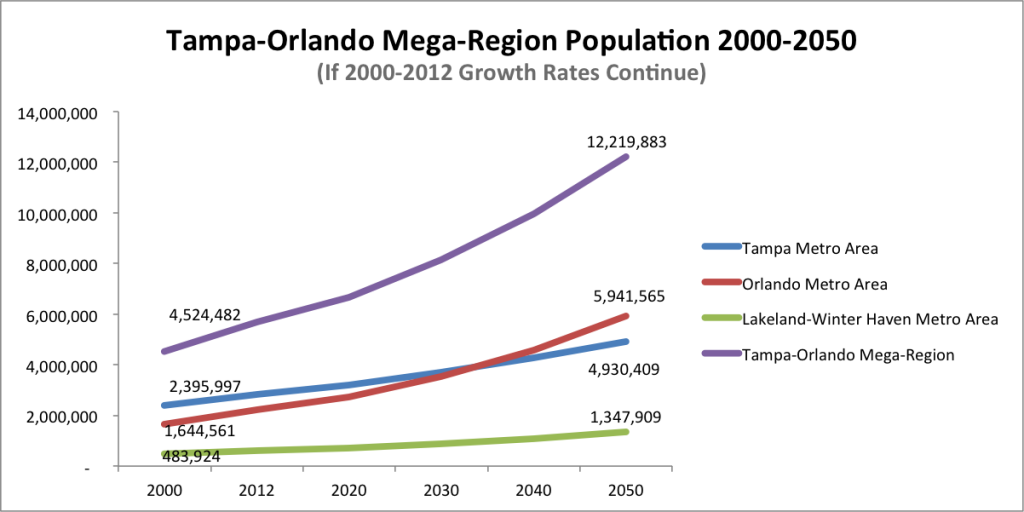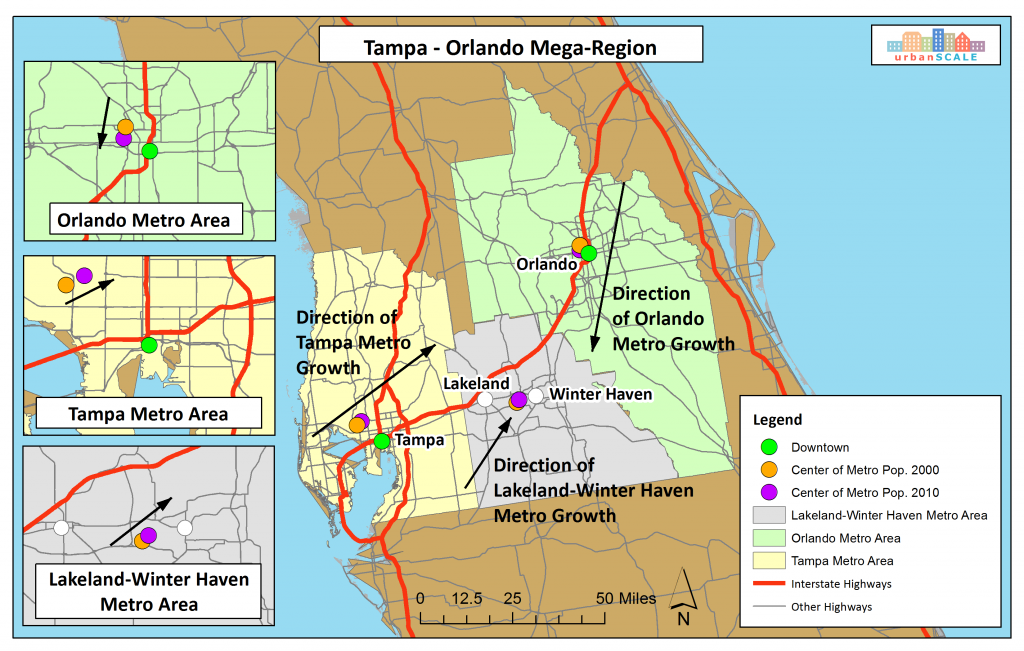Ingredient #1: Two or more growing metro areas.
Ingredient #2: A rapidly growing in-between zone.
Ingredient #3: Multiple transportation connections.
Ingredient #4: Complementary growth patterns.
Ingredient #5: A diversified regional economy.
This post is about the 5 must-have ingredients for creating a new mega-region out of 2 or more individual metro areas.
There are many of examples of potential future mega-regions in the U.S., but I’ve chosen to focus here on 2 of the largest, fastest-growing future mega-regions:
- Austin-San Antonio, Texas
- Tampa-Orlando, Florida
For both of these future mega-regions I’ll do some basic trend analysis to show what the regional population could be by 2050 (of course, it’s important to be aware of the limitations of trend analysis. I will also analyze the growth patterns of the metro areas, including the small, but important, in-between cities. Lastly, I’ll describe in more detail the 5 key ingredients needed to create a mega-region, referring back to the Austin-San Antonio and Tampa-Orlando examples as case studies.
A burning question about urban growth…
Ever since I was a kid, I’ve been fascinated with how cities grow. During high school, I moved to New Braunfels, TX a small city that sits on the IH-35 corridor between San Antonio and Austin. After exploring my new surroundings and seeing all of the growth and construction, I developed a burning question: Would the San Antonio region and the Austin region ever grow together and become one? And if so, what would it take to make this happen? And how long would it take?
Have you asked yourself these questions too?
Maybe you’ve had similar thoughts about the region where you live. If you live in Maryland, maybe you’ve wondered when Baltimore and D.C. would grow together to form a single region…it’s happening before our eyes.
If you grew up decades ago in South Florida, maybe you wondered when Miami would connect with West Palm Beach to form a single region…and it did.
If your great grandparents grew up in North Texas, maybe they wondered what would eventually become of the prairie lands between the town of Dallas and the “Cowtown” 30 miles to the west known as Fort Worth…fast-forward a century later and you have a sprawling metro area of nearly 7 million residents, the 4th largest in the U.S.
2 future mega-regions: Austin-San Antonio & Tampa-Orlando
I could start out by saying that this blog post is all about 2 new mega-regions that will be created by 2050: Austin-San Antonio and Tampa-Orlando. And it is, but…
This blog post is just as much about the small cities that sit in the crosshairs of regional growth in both examples, the “in-between” cities. The growth of these small cities is perhaps the most important of the 5 ingredients necessary to create a new mega-region. These small cities include: New Braunfels and San Marcos in Texas, and Lakeland and Winter Haven in Florida. Chances are good that you’ve never heard of these cities if you live outside of Texas or Florida.
First, what is a mega-region? The America 2050 project, sponsored by the Regional Plan Association, provides a good overview of mega-regions on a larger scale. The ultimate large-scale mega-region is the BosWash (Boston to Washington, D.C.) corridor that is home to nearly 50 million people and includes the metro areas of Boston, Providence, Hartford, New York, Philadelphia, Baltimore, and D.C.
But, for our purposes here we will focus instead on mega-regions that can actually become a single metro area with a unified regional economy. For example, the Texas Triangle mega-region includes the individual metro areas of Dallas-Fort Worth, Austin, Houston, San Antonio, and everything in between. But this mega-region will never become a single metro area. The Austin and San Antonio metro areas, on the other hand, could grow to become a single functioning urban region. Let me explain.
Future Mega-Region #1: Austin-San Antonio
Of course, for the Austin-San Antonio region to ever become a single metro area, the primary cities – Austin and San Antonio – must continue to grow and serve as the engines for their respective regional economies. But this will not be enough to create a new mega-region. What happens in the smaller cities in between the two larger cities is equally important. These in-between cities – San Marcos and New Braunfels – will determine if Austin and San Antonio become a mega-region.
The Austin-San Antonio corridor is perfectly primed to become a mega-region for several reasons:
- Both metro areas are growing rapidly. San Antonio’s metro area population grew by 30.5% from 2000 to 2012. And the Austin metro area grew by 46.8% during this period. In fact, Austin has recently been named the fastest-growing large city in the U.S., for the 4th year in a row now.
- There are plans to connect Austin and San Antonio via commuter rail.
- A second highway – State Highway 130 – was recently built connecting the two regions, helping to cement the economic ties between the two cities.
- The region’s two critical in-between cities – San Marcos and New Braunfels – are both growing rapidly and show strong potential to become important regional centers.
Let’s talk a bit more for a minute about the growth potential of San Marcos and New Braunfels. San Marcos is undergoing an unprecedented population boom. The city is also making serious progress toward the development of a vibrant downtown district. And Texas State University, a major university located in San Marcos, continues to expand.
New Braunfels, home to Schlitterbahn, one of the nation’s most popular water parks, also appears poised to continue its rapid economic and population growth. The recently approved Veramendi development includes 5,000 homes in addition to retail, corporate campuses, medical offices, a resort hotel, university campus and two elementary schools. A new full-service hospital that is part of the rapidly expanding Town Center at Creekside development will also provide a major boost to the New Braunfels economy.
The only ingredient that is somewhat of a barrier to the formation of a future Austin-San Antonio mega-region is the region’s growth patterns. Take a look at the map below.
Austin’s metro area is growing away from San Antonio. Austin’s regional center of population is almost 4 miles north of downtown Austin, and the region continues to grow farther to the north at a pace of about 1/10 mile each year. However, the reality is that the Austin region is growing rapidly in every direction…it just happens to be experiencing more growth to the north and northwest. Also, the San Antonio region is growing in the same direction. So, if anything, the regional growth patterns might slow down the formation of an Austin-San Antonio mega-region, but they don’t appear to pose much of a threat.
Future Mega-Region #2: Tampa-Orlando
You might remember the now infamous refusal of federal government money by Florida Governor Rick Scott for a high-speed rail line that would have connected Tampa and Orlando. Despite that public policy gaffe, Tampa and Orlando still have great potential to become a mega-region…it just might take longer without the high-speed rail.
Just like the Austin-San Antonio region, the Tampa-Orlando corridor is likely to become a mega-region for several reasons:
- All 3 metro areas in the region are growing rapidly.
- The Tampa metro area and the Orlando metro area are growing toward each other (check out the map below).
- The Orlando metro area is constructing a new commuter rail line, Sunrail, that will launch service soon, connecting downtown Orlando to its northern suburbs. And downtown Tampa has the Teco Line Streetcar, which connects several destinations in the city’s urban core. Both of these systems will serve as important assets to any future passenger rail system that connects Tampa to Orlando.
- The region’s in-between cities – Lakeland and Winter Haven – are both poised for strong economic and population growth.
Let’s take a closer look at the region’s in-between cities, Lakeland and Winter Haven.
Winter Haven’s new LEGOLAND Florida is the largest LEGOLAND amusement park in the U.S. and the 2nd biggest in the world. And LEGOLAND Florida, which opened in 2011, continues to fuel growth of related businesses in Winter Haven.
In Lakeland, the new USF Polytechnic University is well on its way to becoming a reality. Over the next few decades, this campus could become a major factor in connecting Orlando and Tampa into a unified economic region.
Also, the zone between Orlando and Tampa (especially Lakeland) is becoming a hotbed of activity for new distribution centers that serve all of Central Florida. Here are Amazon’s plans for a new mega-warehouse in Lakeland. Trader Joe’s is also considering this corridor as an option for a new distribution center.
Similarities between Austin-San Antonio and Tampa-Orlando
The parallels between the Austin-San Antonio region and the Tampa-Orlando region are pretty striking:
- The distance from downtown Austin to downtown San Antonio is 75 miles. The distance from downtown Orlando to downtown Tampa is also 75 miles.
- In both regions, the smaller of the two major metro areas (Orlando and Austin) is growing at a faster pace than the larger one (San Antonio and Tampa) and is on track to eventually become the larger metro area within the next 20 years.
- The 2 larger metro areas (Tampa and San Antonio) both have economies dominated by a major corporate and military presence.
- The 2 slightly smaller, but faster-growing metro areas (Orlando and Austin), are both fueled by a large, rapidly growing high-tech/creative sector. Here’s an overview of Orlando’s high-tech industry. And here’s a recent report on Austin’s status as a major technology hub.
- Both mega-regions have one small in-between city with a major tourist destination (LEGOLAND in Winter Haven and Schlitterbahn in New Braunfels) and one small in-between city that is poised to experience university-related growth (Florida Polytechnic University in Lakeland and Texas State University in San Marcos).
5 key ingredients to create a mega-region
So, we can now revisit the title of this post: What are the 5 key ingredients that need to be in place to create a mega-region? And do the Austin-San Antonio and Tampa-Orlando regions have these critical ingredients?
Mega-Region Ingredient #1: Two or more growing metro areas
This ingredient doesn’t need much explaining does it? It’s sort of the pre-requisite to be considered a candidate for future mega-region status. For a mega-region to form, the individual metro areas must each have strong economies and growing populations. Both of our example mega-regions have this ingredient.
Mega-Region Ingredient #2: A rapidly growing in-between zone
This is the secret ingredient, the linchpin, of the mega-region. For two large metro areas to be successfully joined into a more unified region, the zone between the larger cities must grow rapidly, and the small cities in this zone must become centers of significant regional importance. Both Tampa-Orlando and Austin-San Antonio have in-between zones that are growing rapidly and poised for continued growth.
Mega-Region Ingredient #3: Multiple transportation connections
Transportation connections must exist between the two metro areas along multiple corridors and with more than one mode of transportation. This means that a true mega-region will have highways and passenger rail, not just two highways connecting the region.
For two metro areas to really function as one, they need a shared labor pool. Workers from one metro area must be able to easily access jobs in the other metro area, and vice versa. How can this be achieved? Transportation infrastructure. And for a mega-region to have a properly functioning shared labor market, there must be an extensive public transit connecting the two metro areas. If the only connections between two large urban areas are highways, the traffic congestion and auto-dependency will severely limit the possibilities of a unified regional economy simply due to the long travel times between the two cities.
Now, imagine with me for just a moment that high-speed rail of up to 200 mph becomes a reality in our lifetime. If this big-and-bold scenario actually happened, maybe the Texas Triangle region really could become a unified mega-region. If you could get from Austin to Houston in less than 1 hour, and from Houston to Dallas in just over 1 hour, that really would be a game-changer, wouldn’t it? But for now, mega-regions will need to be confined to metro areas that are less than 100 miles apart.
This is the only ingredient that is presently lacking from our example regions. I’ll be very blunt: For Austin-San Antonio and Tampa-Orlando to become successful mega-regions, they both need passenger rail connecting their downtown districts in addition to improved local transit options (streetcar, light rail, commuter rail).
Mega-Region Ingredient #4: Complementary growth patterns
Most rapidly growing metro areas experience growth in all directions. But this growth is rarely balanced. In most cases, one side of a region captures a disproportionate amount of the metro area’s population growth. Unfortunately, most regions are growing away from their Central Business District (CBD). I’ve written more on this trend here. For two metro areas to grow into a single mega-region, they would ideally both be growing toward each other, but at least they should not be growing in completely opposite directions.
The Tampa metro and Orlando metro fit this ingredient perfectly as both metro areas are growing toward each other in the direction of Lakeland and Winter Haven, which sit in the middle of the corridor.
In the Austin-San Antonio example, both regions are growing in the same northerly direction but they are not growing toward each other. And although the Austin metro area is experiencing rapid growth in every direction, there is more growth on the northern half of the region, away from the San Antonio metro. So, this places even more importance on the growth of New Braunfels and San Marcos, the in-between cities, to create a mega-region.
Mega-Region Ingredient #5: A diversified regional economy
This one is not just a must-have ingredient, it’s actually the biggest benefit provided by the creation of a mega-region. If you’ve been asking yourself since the beginning of this post, “Yeah, but why should I want my city to become part of a mega-region?”, then here is your answer.
A mega-region that functions as a single regional economy with a shared workforce, but contains two or more distinct areas, each with its own economic strengths and unique assets, is an ideal situation for economic development. Austin-San Antonio and Tampa-Orlando are both well on their way to having this ingredient, assuming that they can achieve a more integrated labor market with future passenger rail investments.
Here are the economic development benefits provided by a mega-region:
- The mega-region as a whole is far more diversified and less prone to economic downturns than each individual metro area.
- Businesses in a mega-region have access to a much larger range of potential customers, partners, and suppliers.
- Workers gain a much wider range of employment possibilities.
- Residents can access a greater amount of entertainment, shopping, and recreational opportunities.
Do you live in an existing or future mega-region?
Austin-San Antonio and Tampa-Orlando are two of the best examples of emerging mega-regions, but they are by no means the only areas with potential to become future mega-regions. A few other areas that also have strong potential to become mega-regions include:
- The Metro Denver region and the corridors to the north (Fort Collins-Greeley) and south (Colorado Springs)
- The Greater Salt Lake area and areas to the north (Ogden) and south (Orem-Provo)
- Northern California (the San Francisco Bay Area/Silicon Valley, Sacramento, Stockton-Modesto)
What do you think? What are your favorite examples of existing or future mega-regions?








John — Great article. The whole time I was reading I was comparing this with my city, Sacramento. I’m an Adviser for Mayor Kevin Johnson and this trend is something we’re keen to explore. Very glad to see at the end you mention Northern California as a potential mega region. Would love to hear more if you can spare the time.
James-
Thank you for your comments. Yes, I’d love to learn more about what you’re working on in Sacramento. Northern California broadly speaking was actually the 3rd mega-region I almost included in this blog post. Definitely makes sense to think of things regionally, especially from a local government viewpoint.
Great article! Thanks. As an Orlando resident with connections in the Tampa area, I was also disappointed in Rick Scott’s refusal of the high speed rail. I know it will happen eventually, but we could have been the first.
Thank you, Chad! Yes, Tampa & Orlando are a great example of a potential mega-region. And the latest Census estimates that came out last week add further fuel to this. Nearly 120,000 new residents between the 2 MSAs from 2014-2015. Add in Lakeland-Winter Haven and you’re well over 130,000 residents in just 1 year!